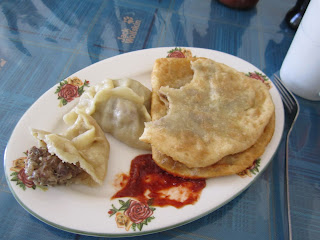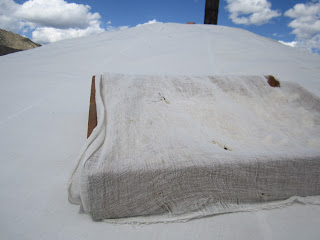Back in UB, after a long trip to Western Mongolia (which I will post about at some point) I saw a Mongolian BBQ place. Or perhaps better to say, THE Mongolian BBQ place in Mongolia. As my long sojourn had demonstrated- there is no such thing as Mongolian BBQ out in the countryside. The only BBQ place in UB is on the corner of "what passes for souvenirs in Mongolia" street, and "high end foreign catering coffeeshops set in Khrushchev era buildings" avenue.
It's apparently the first American chain restaurant to open in Mongolia. Hurray the ironies of globalization.
Before I came here, everyone told me how awful the food was. But that really isn't accurate. It's not bad, it's boring. It's always some variation of meat and noodle, or milk. And it lacks anything resembling taste.
Here's some real Mongolian food for you:
Buuz and Khuushuur
Sometimes you get lucky and get some ketchup.
Buuz are dumplings made of white flour noddles stuffed with fatty mutton and then steamed. Khuushuur is essentially the same thing but pounded flat and deep fried. Definitely of Chinese origin.
Pretty rich food to eat during the summer, but you could see where it would do the trick when it's negative 30 out.
Aarul
Aarul is dried milk curds. Basically they dry the curds of the milk on the roof of their ger.
Sun soakin' bulges in the shade
It's hard as a jaw breaker. You have to gnaw off bits of the block in order to get any of it in your mouth. Then you are rewarded with a sour milk flavored jolly rancher.
But it lasts forever. I interviewed a herder that made enough aarul to sell it. He would make it all year long, and then, once in the winter, a guy in a truck would buy all of his product at once. And the stuff didn't go bad.
The Kazakh version of aarul. It's deep fried.
Tsuvain
I wonder who thought, "You know what these starchy noodles need? More starch!"
Tsuvain is another typical Mongolian noodle dish that probably originates in China. This is typically a mix of noodles, potatoes and some meat. Strangely, the potatoes and noodles kind of work together.
When I visited the Kazakhs, they served me tsuvain with horse. It was surprisingly good.
Milk Tea (Suutei tsai)
Bane of my culinary life
Everytime you enter a ger, this awaits you : milk tea. It's a major embarrassment not to have any to serve to your guests, and it is a big insult to refuse it.
It's made by boiling some water and adding an equal part of whole milk, a table spoon of salt, and a tiny bit of cheap green tea. Since my work takes me to a lot of gers, I find milk tea to be a major source of my calories. Also, if my next cup I had to drink didn't come to me until after the sun had gone supernova, it would be too soon.
So my readers, appreciate all the pizza, Thai food, and burritos you've got. Because whatever you're eating, it's probably more exciting than Mongolian food. As for me, I'm looking forward to some Mongolian BBQ when I get home.










































